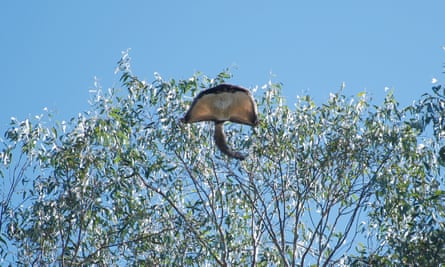Government surveys have found tens of thousands of endangered greater gliders could be living within the proposed area for a great koala national park in New South Wales, prompting new calls for the area to be quickly protected from logging.
Data from aerial drone and ground-based surveys at 169 sites within the proposed park were used to model the likely presence of Australia’s largest gliding possum across the entire 176,000 hectares the NSW government is considering for protection.
The Minns Labor government promised to create a koala national park before the state election more than two years ago, but has not taken a decision on the boundaries and has allowed logging to continue.

Between April and July 2024, the surveys detected greater gliders at 82 sites. The government’s analysis estimated the planned park has between 29,693 and 44,211 gliders, with a mean estimate of 36,483. Some survey sites in the north-west recorded “extremely high detections” of the species, according to the new report.
“This puts paid to any argument that this is not an environmentally significant area and endorses the protection of the complete 176,000 hectares in a national park,” Justin Field, spokesperson for the Forest Alliance NSW and former independent member of the NSW upper house, said.
A great koala national park in in the state’s north was NSW Labor’s key environmental commitment at the 2023 election but, two years on, the government has given no indication of when it will announce how much of the 176,000 hectares it plans to protect.
“The politically pointed question is: why is Chris Minns allowing the great potential legacy of this park to be undermined by a slow decision?” Field said.
A NSW government spokesperson said the creation of the park was “one of our key election commitments, and it will be delivered soon”.
“Creating this park will protect koalas, and that protection will extend to other important species including gliders.”
Community groups and conservation advocates have grown increasingly frustrated as the government has allowed logging to continue within the proposed park instead of declaring a moratorium until assessment is complete.
“These gliders do not tolerate logging and this report should motivate the Minns government to immediately end logging in the proposed great koala national park,” the chief executive of the Nature Conservation Council of NSW, Jacqui Mumford, said.
“In fact, logging should cease in all state forest areas identified as containing greater gliders.”
after newsletter promotion
Kita Ashman, a threatened species and climate adaptation ecologist at WWF Australia, said the report highlighted the significance of the proposed park for multiple species.
“That’s the crux of the whole story,” she said.
“Yes, we’re calling it the great koala national park. But you could easily call it the great greater glider national park – although it doesn’t have the same ring to it.”
The forest alliance, made up of community and state environment groups focused on forest conservation, said it was also concerned about the findings of the government surveys for another glider species, the vulnerable yellow-bellied glider.
The report found yellow-bellied gliders were less abundant than other species assessed, with the drone and on-ground surveys detecting the animals at only 21% of the sites.
Because of the low number of observations, the government was unable to estimate an overall population number for the species within the park area.
Field said this highlighted a need for further investigation to understand its conservation status.










